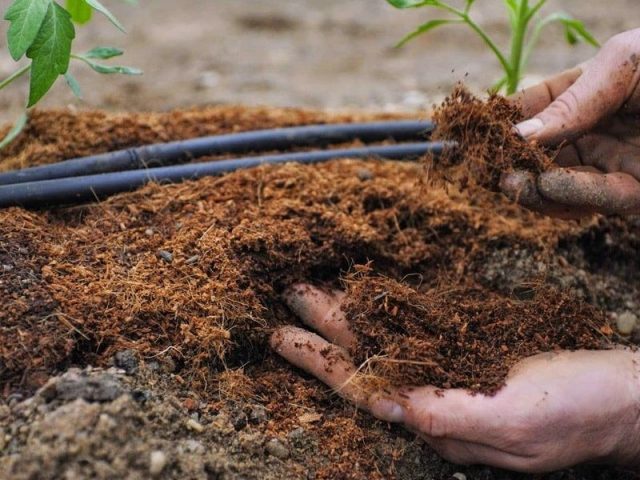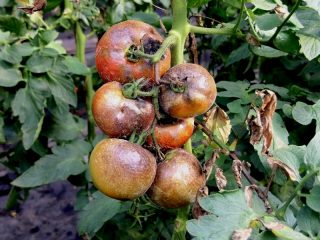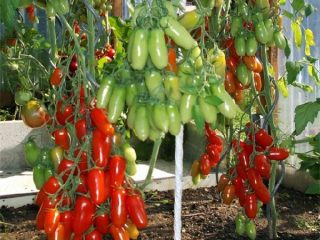Content
All gardeners who have experience in growing this vegetable recommend mulching tomatoes. This procedure helps to increase its yield, helps maintain soil moisture for longer, and prevents weeds from growing too much. But for mulch to be truly useful, you need to choose the right material for it and lay it out on time.

You can mulch tomatoes in different ways, each of which has its own pros and cons.
What is soil mulching for tomatoes?
Mulching tomatoes means creating a cover for the top layer of soil where they grow with suitable materials that will help protect the soil from drying out and improve its properties. The undoubted advantages of the procedure include:
- reducing the number of waterings;
- less weed growth;
- protection of the root system from bad weather;
- attracting earthworms;
- regulation of soil pH;
- protection against rot and fungal diseases.
Because of such an abundance of advantages, the gardener can rest assured that the answer to the question of whether tomatoes can be mulched will be positive. The main thing is to choose the right material for mulch so that it does not oppress the crop and benefits it.
What is the best way to mulch tomatoes?
Tomatoes can be mulched in a greenhouse and in open ground. You can use different compositions for this; in particular, vegetable growers prefer organic natural ingredients. They are loved because they not only protect plantings from diseases, weeds and temperature, but also for enriching the soil with useful elements, mainly nitrogen.
Inorganic components are more durable materials that last more than a year. They protect the roots of the crop from cooling and overheating, keep the soil loose and moist, and prevent weeds from growing. These include paper materials, burlap, non-woven fabric and film.
Compost
Mulching tomatoes with compost is considered very effective and healthy, the main thing is not to overdo it. The substance is added with caution, preferably mixed with other materials, such as sawdust. The latter strongly draw nitrogen released by compost from the soil, as a result of which the components neutralize each other and bring only benefits to the tomatoes. The disadvantages of this method include the rapid disappearance of the layer, as it is eaten by worms.

Compost is one of the most common nitrogen-containing fertilizers
Grass
If you mulch tomatoes with weeds and mown grass, the soil in the beds will be well saturated with microelements, which will help increase its fertility. But you should know that insects living on this material can move onto tomato bushes and harm them. Because of this, before laying the grass on the beds, it is recommended to dry it in the sun.

You need to mulch the beds with grass in a layer no more than 3 cm high.
Needles and fallen leaves
Some gardeners prefer to mulch tomatoes with pine needles or leaf litter, but first the material is well dried and checked for the presence of insects. To prevent the soil from acidifying, pine needles are mixed with dolomite flour or chalk before use.

You cannot immediately cover the beds with leaves or pine needles.
Sawdust, wood chips, tree bark
It is allowed to mulch tomatoes with tree bark, sawdust or wood chips only after they have been pre-treated, as otherwise they will draw a lot of nitrogen from the ground. Before use, sawdust is soaked in a 5% urea solution, and wood chips and tree bark are kept in the open air for a year, thereby aging them.

Fresh wood waste is not suitable for mulching tomatoes
Straw, hay
Hay and straw are also good components for covering beds, but to prevent infection with anthracnose, rot or spotting, you should know that it is best to mulch tomatoes with straw from cereals.This material is considered thermal insulating and retains moisture in the soil for a long time. But rodents often live under it, which is why it is recommended to frequently turn the hay in the beds.

Straw and hay perfectly protect the soil from hypothermia
Peat
If you mulch tomatoes with peat, this can lead to a strong increase in soil acidity, which is why it is also not used fresh. Before covering the beds, the material is mixed with compost, chalk, flour or other substances that neutralize the reaction.

Peat is good for slightly acidic soil
Cardboard, newspapers, paper
Most often, materials from the pulp and paper industry are used to mulch the soil in a greenhouse with tomatoes. The beds can be covered with newspapers, paper and even cardboard.

In open ground, such mulch quickly decomposes
Non-woven fabric
Non-woven fabric - lutrasil - is sometimes used as inorganic mulch. This is a black material that allows water and oxygen to pass through well, protecting tomatoes from pests and fungal diseases. It is durable, lasts up to five years.

Mulching tomatoes with lutrasil is expensive
Sackcloth
Burlap is a cheaper type of mulch. It allows air and water to pass through well, but the soil underneath dries quickly. Tomatoes that you decide to mulch with burlap will have to be watered quite often.

To avoid washing out the beds, water should be poured over the burlap.
Film
The decision to mulch tomatoes with film is most often made in the cold season. It warms the soil, retains moisture well, and frees the gardener from the need for frequent watering. In summer, the material is removed because it causes overheating of plant roots.

When covered tightly, the film increases the soil temperature by several degrees
How can you mulch tomatoes in a greenhouse?
According to experienced vegetable growers, it is more effective to mulch tomatoes in a greenhouse using natural materials. As they decompose, they gradually turn into humus and become a good fertilizer for tomatoes, which leads to their active growth and development. Since it is impossible to achieve all goals with one material, mulch is often made into layers. For example, first compost or hay is placed on the bottom, which will provide nutrition to the earth, and then straw is laid out, it will serve as a thermostat, preventing weeds from growing and moisture from evaporating.
Many gardeners consider black film to be the best mulch for tomatoes in a greenhouse. The fact is that the greenhouse has poor ventilation and the air there constantly stagnates, and such shelter helps to avoid this. The film practically does not allow moisture to evaporate and significantly reduces water consumption during irrigation.
Mulching tomatoes in open ground
Since the problem of outdoor beds is the constantly scorching sun and blowing wind, mulch for tomatoes in open ground should prevent the formation of a crust on its surface and provide access to oxygen to the root system of the plant. Organic materials sprinkled in a layer of 5 cm are best suited for this.
What not to use for mulch
Not all materials can be used to mulch tomatoes. Roofing material and fresh manure cannot be used for this purpose. The first one releases many toxic substances during decomposition, which, when watering the beds, fall into the soil and are absorbed by the roots of the crop; the second contains too much nitrogen, the excess of which leads to rapid growth of green mass, abundant flowering, but poor fruit formation and low yield.
When and how to mulch tomatoes correctly
Competent gardeners begin to mulch tomatoes when the soil has completely warmed up and the threat of frost has passed. There is no rush with this procedure, since if it is carried out ahead of time, the plant roots will become hypothermic and the bushes will die. This rule does not apply only to beds in a heated greenhouse.
Typically, in a greenhouse, mulching begins after planting seedlings; in open ground, organic mulch is laid out between already grown bushes, and inorganic mulch is placed before planting. When using non-woven material or film, the entire area is covered with it, and then slits are made in the right place and seedlings are placed in them.

The thicker the mulch layer, the better it retains moisture.
Conclusion
You can mulch tomatoes both indoors and outdoors. There are many materials for carrying out this procedure, and each gardener can choose the one that suits his beds best.Properly organized mulching will help to significantly save time when caring for the crop, increase its yield and protect it from troubles in the form of insects and diseases.








